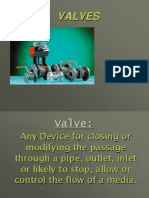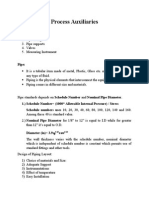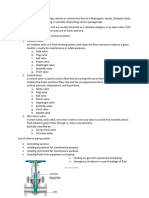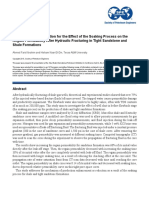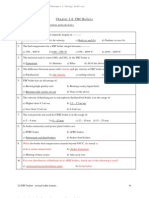Section
Section
Uploaded by
Felicia TanCopyright:
Available Formats
Section
Section
Uploaded by
Felicia TanCopyright
Available Formats
Share this document
Did you find this document useful?
Is this content inappropriate?
Copyright:
Available Formats
Section
Section
Uploaded by
Felicia TanCopyright:
Available Formats
Section - I A: Valves By: Anton Dooley A valve is a mechanical device that regulates the flow of fluids (either gases,
fluidised solids, slurries or liquids) by opening, closing, or partially obstructing various passageways. Valves are used in a myriad of industrial, military, commercial, and residential applications. There are many different types of valves: Ball valve, which is good for on/off control; A ball valve (often called a quarter turn valve) is a valve that opens by turning a handle attached to a ball inside the valve. The ball has a hole, or port, through the middle so that when the port is in line with both ends of the valve, flow will occur. When the valve is closed, the hole is perpendicular to the ends of the valve, and flow is blocked. The handle position lets you "see" the valve's position.
The body of ball valves may be made of metal, ceramic, and/or plastic. The ball may be chrome plated to make it more durable. There are three general types of ball valves: full port, standard port, and reduced port. A full port ball valve has an oversized ball so that the hole in the ball is the same size as the pipeline resulting in lower friction loss. Flow is unrestricted. A standard port ball valve is usually less expensive, but has a smaller ball and a correspondingly smaller port. Flow through this valve is one pipe size smaller than the valve's pipe size resulting in slightly restricted flow. In reduced port ball valves, flow through the valve is two pipe sizes smaller than the valve's pipe size resulting in restricted flow. Manually operated ball valves can often be closed quickly and thus there is a danger of water hammer. Some ball valves are equipped with an actuator that may be pneumatically or motor operated. These valves can be used either for on/off or flow control. A pneumatic flow control valve is also equipped with a positioner which transforms the control signal into actuator position and valve opening accordingly. There are also three-way ball valves, with a T-shaped hole through the middle. With such a valve the flow can be directed to either one or the other or both sides or be closed off
completely.
Butterfly valve, particularly in large pipes; A Butterfly valve is a type of flow control device, used to make a fluid start or stop flowing through a section of pipe. The valve is similar in operation to a ball valve. A flat circular plate is positioned in the center of the pipe. The plate has a rod through it connected to a handle on the outside of the valve. Rotating the handle turns the plate either parallel or perpendicular to the flow of water, shutting of the flow. It is a very robust and reliable design. However, unlike the ball valve, the plate does not rotate out of the flow of water, so that a pressure drop is induced in the flow. Gate valve, mainly for on/off control; A gate valve is a valve that opens by lifting a round or rectangular gate out of the path of the fluid. Gate valves are sometimes used for regulating flow, but many are not suited for that purpose, having been designed to be fully opened or closed. When fully open, the typical gate valve has no obstruction in the flow path, resulting in very low friction loss.
Most gate valves have a rising or a nonrising stem.
Rising stems give a visual indication of valve position. Nonrising stems are used where vertical space is limited. Bonnets* provide leakproof closure for the valve body. Gate valves may have a screw-in, union, or bolted bonnet. Screw-in bonnet is the simplest, offering a durable, pressure-tight seal. Union bonnet is suitable for applications requiring frequent inspection and cleaning. It also gives the body added strength. Bolted bonnet is used for larger valves and higher pressure applications. * Bonnets provide leakproof closure for a gate valve or globe valve body. Globe valve, which is good for regulating flow; Globe valves are named for their spherical body shape. The two halves of the valve body are separated by a baffle with a disc in the center. Globe valves operate by screw action of the handwheel. They are used for applications requiring throttling and frequent operation. Since the baffle restricts flow, they're not recommended where full, unobstructed flow is required. A bonnet provides leakproof closure for the valve body. Globe valves may have a screw-in, union, or bolted bonnet. Screw-in bonnet is the simplest bonnet, offering a durable, pressure-tight seal. Union bonnet is suitable for applications requiring frequent inspection or cleaning. It also gives the body added strength. Bolted bonnet is used for larger or higher pressure applications. Many globe valves have a class rating that corresponds to the pressure specifications of ANSI 16.34. Check valve or Non-return valve, allows the fluid to pass in one direction only; A check valve is a mechanical device, a valve, that normally only allows fluid to flow through it in one direction. A double check valve is often used as a backflow prevention device to keep potentially contaminated water from siphoning back into municipal water supply lines.
A clapper valve is a type of check valve used in or with firefighting, and has a hinged gate (often with a spring urging it shut) that will only remain open in the outflowing direction. Some types of irrigation sprinklers and drip irrigation emitters have small check valves built into them to keep the lines from draining when the system is shut off. A pressure relief valve or safety valve operates automatically at a set differential pressure to correct a potentially dangerous situation, typically over-pressure. A pressure relief valve opens to release excess pressure when the pressure is too high to protect the vessel or other equipment from overpressurization. A relief valve is like a safety valve in that it is for liquids only. A safety valve is for gases only. High purity valves, are flow control devices that meet the industry criteria or purity of materials and design.
Section - I B: Pipe By: James O. Pennock Definition: Pipe is a hollow "tube" used for conveying products and pressure. The products include fluids, gas, slurry, powders, pellets and more. The pressure is hydraulic power. We usually designate the "tube" as pipe in the applicable line class but the definition includes any similar component designed as tubing, which is used for the same application. Materials of construction: The various kinds of material from which pipe is, or can be, made is proved to be endless; among them are the more common carbon steel, along with chromes, stainless steel, iron, brass, copper, lead, aluminum, glass, rubber and various types of plastic material. Over the years some of these materials have been combined to form lined pipe systems. These include carbon steel pipe lined with glass, carbon steel pipe that is lined with various plastics; carbon steel pipe lined with concrete. Each one, plain or lined has certain advantages and disadvantages. Many things enter into making a choice of materials. Among the most important of these are commodity, pressure, temperature, size, ease of assembly availability and economics. Pipe sizes: Many years ago pipe was sized by its true inside diameter. i.e., a 1" pipe was actually 1" inside diameter. However, as time went on and the methods of manufacturing were improved and made more standard, and because it became necessary to increase wall thickness to accommodate higher pressures and temperatures, it became necessary to size pipe by "nominal" size rather than actual size. Because it was deemed too expensive to have a set of thread dies for each wall thickness in the smaller sizes, the outside diameter (O.D.) was held constant. Thus wall thickness changes affect the internal diameter only and leave the O. D. constant for standardized fitting engagements. Nominal size refers to the name by which we call a particular size pipe. Nominal size and actual outside diameter of a pipe differs for size 12" and under. For sizes 14" and larger the actual outside diameter and the nominal size are identical. Pipe comes in a very wide range of sizes. It is not uncommon to see piping as small as " or as large as 66". Pipe mills can and will make almost any size for a price. This does not always prove to be the economical choice because odd size fittings may not be available. It is best to stick to the closest and most commercially available or common size to meet the need. The smaller common sizes in pipe include ", ", 1", 2", 3", 4", 6", 8" 10" and 12". The larger sizes, 14" and above increase in 2" increments. The Nominal size pertains to calling the pipe size by name only. The actual outside diameter or O. D. is different for the 12" and under sizes. Example: Nominal Size Actual O. D. 15/16" 2" 21"
3" 4" 12" 14"
3/8" 31/2" 41/2" 123/4" 14"
For all pipe sizes the inside diameter varies as the wall thickness increases thus the thicker the wall, the smaller the inside diameter. Weight: Many years ago the only "weights" of pipe available were classed as standard weight, extra heavy and double extra heavy. Within the last seventy-five years or so it became increasingly evident that this system was limited in scope and did not meet the needs of the growing state of the industry. This was the direct result of the increasingly higher pressures and temperatures of the commodities being handled. Consequently the use of schedule numbers came into being. Today, both weight and schedule are the way of identifying the wall thickness. Length: Based on common practice pipe usually can be furnished in "single random" lengths, "double random" lengths, and under certain circumstances (pipeline work for example) in even longer lengths. A single random will run from about 16' to 22' in length. A double random will run from about 35' to 40' in length. Pipe can be ordered to a specified fixed length but this will cost more. Methods of manufacture: Pipe is made two ways. It is made by taking a flat plate, called a skelp, and rolling it into a tube shape and then welding the two edges together to form a tube. This pipe is commonly called "welded pipe" or ERW pipe. The other way is to take a solid bar or billet and pierce a hole through the length. This pipe is commonly called seamless pipe. Determining wall thickness: The wall thickness for pipe is generally covered in the piping material specifications by calling out the Schedule Number for a large majority of sizes. However, as pressure and temperature increase, and sometimes the corrosion allowance, it becomes necessary to calculate the required wall thickness for a specific case. Please note that generally as the specifications change into higher-pressure classes, wall thickness calculations must be made for smaller size pipe. Wall thicknesses are by strict adherence to the rules set forth in the code for Pressure Piping. For more detailed information on specific pipe sizes and it's various wall thicknesses, schedules and pipe weights see the "tools," "piping", "pipe chart" on this website
Grades: In steel pipe, the word "grade" designates divisions within different types based on carbon content or mechanical properties (tensile and yield strengths). The tensile strength is the ultimate amount of stretching the steel can bear without breaking. The yield strength is the
maximum amount of stretching steel can bear before it becomes permanently deformed or before it loses its ability to return to its original shape. Grade A steel pipe has lower tensile and yield strengths than Grade B steel pipe. This is because it has a lower carbon content. Grade A in more ductile and is better for cold bending and close coiling applications. Grade B steel pipe is better for applications where pressure, structural strength and collapse are factors. It is also easier to machine because of its higher carbon content. It is generally accepted that Grade B welds as well as Grade A. Ends: Steel pipe can generally be specified with a specific end preparation at the time of purchase. Three end preps are standard. There is plain end (PE). This would be the choice for small sizes where socket welded fittings will be used to join pipe to pipe or pipe to fittings. This is also the default end prep if no end prep is specified. There is threaded end (TE). This would be the choice for small sizes where the pipe to pipe or pipe to fitting assembly is to be threaded. There is also bevel end (BE). This would be the choice for most all 3" and larger steel pipe (or other metallic pipe) where "butt welding will be used to join pipe to pipe or pipe to fittings. Section - I C: Fittings (Just the basics) By: James O. Pennock Definition: A fitting is a pipe item used for changing direction, branching or attaching in a piping system. There are many different types of fittings and they are produced in all the same sizes and weights (schedules) as the pipe. Fittings are commonly segregated into three groups; Buttweld, Socket-weld and Screwed. Only the most common will be discussed in this article.
Materials of construction: Like pipe, fittings are fabricated from several different types of material and usually match the material of the pipe to which they are being attached. Some fittings are Cast Iron, some are Malleable Iron, some are Forged Steel and others are even fabricated from rolled Steel Plate. The most used materials are again common carbon steel, along with chromes, stainless steel, iron, brass, copper, lead, aluminum, glass, rubber and various types of plastic and plastic lined metal materials. Fitting Types: Normally, fittings fall into three basic types or categories. These are In-line, On-line and Closures. The In-line fittings include elbows (Ells), Tees, Couplings and Reducers. The Online fittings include a wide variety of "O-Let" fittings used primarily for making branch connections. The closure fittings are various types of caps and plugs used to close the end of a pipe system. We also will discuss some cases where there are alternates to these normal categories.
Butt-Welded Fittings Elbows (Ells): An Elbow is a piping fitting used for changing direction. There are five basic versions of elbows. The first and by far the most common is the 90 long radius Ell. The second is the 45 long radius Ell. The third is the 90 short radius Ell. The fourth is the long radius reducing Ell. The fifth version is the long radius 180 Return Bend. The basic Butt-Weld Ell is manufactured in 90 or 45 configurations as a standard. However for special order and extra cost, the large sizes can be made in other degrees of turn. The standard Butt-Weld elbows (90, 45 and 180 ) can be altered to meet any special angle needs of a piping system. Elbows like pipe can be flame cut or machine cut to the required angle. The rough end is then ground or machine beveled to the proper angle for welding. There is normally no harm to the fitting when this is done. The terms "Long Radius" and "Short Radius" are important to understand. "Long Radius" means that the center to end dimension is one and a half times the nominal pipe size. Example: Nominal Line Size (and Center-tend of short radius Ell) 4" 10" 14" 20" 24" Center-to-end of long radius Ell 6" 15" 21" 30" 36"
"Short Radius" means that the center to end dimension is equal to the nominal pipe size. This means that the center-to-end for a 4" short radius Ell is 4", for a 10" Ell the center-to-end is 10" and so on. The long radius Ell is the default standard. All elbows shown in a system are assumed to be long radius 90 Ells unless noted otherwise. This means that the designer must call out any and all exceptions to this rule. If the Ell is a 90 long radius Ell then the elbow symbol is all that is required. However, if the Ell is a 45 Ell then the designer must add the notation "45 Ell" next to the elbow symbol. If the Ell is a 90 short radius Ell then the designer must place the notation S. R. next to the elbow symbol. Also if the elbow has been trimmed to any odd angle this too must be noted next to the fitting. As stated above the 90 long radius Ell is the default standard and is the most used. The designed should use the long radius Ell at all times unless conditions exist that force another choice. The short radius 90 Ell should only be used when tight space does not allow the long radius. The 45 Ell is normally used where a simple offset is required for some purpose. The 180 Ell is used mostly by equipment manufacturers to form heating or cooling coils. Return
Bends are not normally required by the piping designer unless there is a requirement to fabricate a complex configuration. The purpose of the 90 long radius Reducing Ell is to do the job of an elbow and a reducer. (Reducers will be covered later.) As such this Ell is made with one end of one size and the other end one or two line sizes smaller. The using of the reducing Ell is not cheaper; it only takes less room. The "long radius" dimension for the 90 long radius reducing Ell is based on the size of the large end. Because the long radius and short radius designation of the 90 Ells are based on the nominal pipe size the designer quickly learns the center-to-end dimensions. The center-to-end dimensions for the 45 Ell are normally found only on a chart. However, there is a short-cut way to "know" these dimensions. You see, these dimensions are also based on the nominal pipe size. This short-cut method works for all 45 Ells from 4" to 24" line size. You can do this in your head. You simply divide the line size in half three times. Take the answer from the first time and the third time and total them up. That will be the dimension for the 45 Ell fitting. Example: Column #5 Fitting dimension (Total of Col. #2 & Col. #4) 2 " 5" 6 " 8 " 12
Column Column #1 #2( Col. (Line size) #1) 4" 8" 10" 14" 20" Tees: 2" 4" 5" 7" 10"
Column #3( Col. #2) 1" 2" 2 " 3 " 5"
Column #4( Col. #3) " 1" 1 " 1 " 2-"
The primary purpose of a Tee fitting is to make a branch from a pipe line (or run). The branch may need to be the same size as the run or it may need to be one or more sizes smaller than the run. Because of economics (the cost of special orders) the use of Tees is normally limited to size-to-size or Straight Tee, (all three connections are the same size) or Reducing Tees where the branch outlet is only one size smaller than run size. Methods for making branches of other smaller sizes will be discussed later. The dimensions of Tees are not as simple as they are for Ells. For Tees you must look them up on a fitting chart. The dimension found there is however standardized between all manufacturers. For Straight Tees the center-to-end dimension of both ends and for the branch outlet is the same. For Reducing Tees the center-to-end of the branch outlet is different from that of the run. Reducers:
A Reducer is a fitting used to change the line size one or more sizes smaller (or larger). There are two versions of Reducers. There is Concentric Reducers- where the centerline of the inlet and the outlet are the same. There is Eccentric Reducers- where the centerline of the inlet is different than the centerline of the outlet. With the Eccentric Reducer, one side is flat. Depending on how it is installed you may have bottom flat (BF) or top flat TF). You may also have a need to have (*) side flat (*= north, south, east or west). It is about a toss-up as to which is used more. Concentric Reducers are used mostly in situations where the reducer is in a vertical run of pipe. Eccentric Reducers are used in horizontal runs of pipe such as pipeways or in pump suctions. The dimensions for reducers must be looked up but are normally standardized among the manufacturers for a given size. The length of a reducer is the same for a range of sizes (Example: The end-to-end dimension for 10" x 4", 10" x 6" and 10" x 8" reducers is 7"). As you can see the length of a Reducer is very short in relation to the diameter. Caps: The weld Cap is a fitting used to close the end of a pipe. The closed end of the Cap is semielliptical in shape. The dimension of a weld cap is a look-up item. Weld caps are most often found at the bottom of a piping configuration called a "Boot." A boot is a short length of pipe with a pipe Cap that is attached to the bottom of steam line and provides for the collection of condensate. Alternates: Here are a few alternates to the normal methods of doing business discussed above. Miters: We talked about elbows as a way to change direction. You can change direction without using elbows. You might do this with a Miter Ell (or Mitre, both spellings are correct). A Miter Ell is where no fitting is used. Miters are normally used in large size/low pressure piping. You fabricate the Miter or change in direction from pipe segments (or pieces) that are cut at specific angles depending on the number of pieces and welds required. This is really effective when really odd angles are required. Two of the pieces are the incoming pipe and the outgoing pipe. There may be no middle piece or there may be one (or more) other short middle pieces depending on the angle of the turn. A simple turn of 45 might be made with a twopiece/one weld miter. Other changes in direction might be three piece/two weld miters, three piece/two weld miters and so on. The number of welds is always one less than the number of pieces. Depending on the size and schedule of the pipe a Miter might be cheaper than buying fittings. In small diameter piping the miter is more expensive (labor costs) and there is more pressure drop through a small miter than a small fitting. Miters are also not recommended for high temperature lines because miters are more susceptible to overstressing. Stub-in (Stub-on):
We talked about using Straight Tees and Reducing Tees as a way to make branches from a line. For low pressure (or reasonably low pressure) there is another way to make branches from a line. This method uses only pipe. It is normally used only for low pressure/low temperature applications where the branch is reducing. The ASME B31.3 (and other piping B31 Code sections) recognize two basic versions of the pipe to pipe branch. One method is where the run pipe has a hole cut the outside diameter of the branch pipe. This opening is then beveled for a "full penetration weld" The branch pipe is saddle cut (with no bevel) to match the I. D. of the run pipe. They are then fitted together and welded. The second method is where the diameter of the hole in the run pipe is the same I. D. as the I. D. of the branch pipe. This hole does not get a bevel. The end of the branch pipe is saddle cut to fit the run pipe and is then beveled for a full penetration weld. With the first method, the branch pipe is inserted in the run pipe. With the second method, the branch pipe is set on the run pipe. Both are still commonly referred to as "Stub-ins" Both of these can come non-reinforced (as described above) or reinforced. The reinforced version is normally only required for higher stress situations. The reinforcement is a "ring" plate cut from some scrape run pipe or the same material as the run pipe. At the center is a hole the same size as the branch pipe. If cut from flat plate it is then shaped to fit around the run pipe. The width of the ring is normally one half the diameter of the branch pipe. The ring is intended to replace the material that was removed when the hole was cut in the run pipe. A small diameter hole (1/4" NPT) is normally drilled (and tapped) in the ring to act as a vent during the welding process and to allow for Hydrotesting of the welds. The ring is then welded to the branch pipe and the run pipe with full penetration welds. The small hole is fitted with a plug after work is completed. O-let fittings: Another way to make branch connections on pipe and vessels is by using an "O-Let" fitting. An "O-Let fitting is designed for use on 3" and larger welded pipe. The main feature of the typical O-Let fitting is the built-up base design which eliminates the need of any other form of branch reinforcement. The O-let fitting is manufactured in a number of styles. These are: Weld-O-Let - (common) - This fitting is best described as an odd shaped "donut." It's purpose is to make self-reinforced branch outlets on a larger (one size or more) run of pipe. The base of the common weld-o-let has a saddle shape to fit the run pipe. The outlet end of the weld-o-let has a beveled-end allowing for butt welding a pipe or fitting. Weld-O-Lets come in a wide range of sizes and materials. The size call-out is normally the run (header) size by the branch size (Example: 24" x 4" WOL). It may be of some interest to know that most O-Let fittings are made with the base that covers a range of header sizes. This means that the 24" x 4" WOL will also fit on all pipe sizes from 24" pipe to 36" pipe. Thread-O-Let - The Thread-O-Let is made much the same as the Weld-O-Let except that the outlet is threaded to match the normal tapered pipe threads. The threaded outlet sizes are normally limited to the smaller (2" and under) pipe sizes.
Sock-O-Let - The Sock-O-Let is also made much the same as the Weld-O-Let except that the outlet has a socket to match the socket welded piping fittings and pipe. The socket outlet sizes are normally limited to the smaller (2" and under) pipe sizes. Latrolet - A Latrolet is a weld on branch fitting that is attached to the run pipe at a 45 angle. The angle attachment is sometimes required on high pressure relief systems. A Latrolet may be ordered with; a Butt-weld outlet end, a threaded outlet end or a socket weld end. Elbowlet - The Elbowlet is made to be fitted on the back side of a long radius 90 elbow. An Elbowlet may also be ordered with; a Butt-weld outlet end, a threaded outlet end or a socket weld outlet end. Nip-O-Let - A Nip-O-Let is a fitting that has the reinforced base for attaching to the run pipe and then has a short pipe extension with a threaded or plain outlet end. The Nip-O-Let does come in a range of sizes, however they are limited to the smaller sizes. This fitting is normally used for vent, drain and pressure gage connections. Flange-O-Let - This fitting is much like the Nip-O-Let but has a flanged outlet end. The purpose is the same as for the Nip-O-Let.
Couplings: (as a branch outlet fitting) The common pipe Coupling (to be discussed later) can also be used in the making of small size branches from a larger header or run pipe. One end of the (Threaded or Socket Weld) Coupling is shaped to match the O. D. of the larger pipe. This shaped end is then ground to form a beveled end which allows for a full penetration weld. Screwed and Socket-Welded Fittings These fittings perform the same function as the Butt-Weld fittings. There function is the same but the method of joining and the dimensioning is different. Normally these fittings are used in sizes 1-1/2" (or 2") and smaller. Welded fittings are specified the same as the pipe, by weight, schedule or wall thickness. Screwed and Socket-Weld fittings are specified per the pressure class. Thread engagements as well as the depths of the sockets for different pipe sizes are different and must be looked-up on an approved dimension table. Threaded fitting pressure classes: 125# Cast Iron 250# Cast Iron 150# Malleable Iron 300# Malleable Iron 2000# Forged Steel * 3000# Forged Steel * 6000# Forged Steel * Most common
The Cast Iron and Malleable Iron fittings are basically used for air and water services at a low temperature and pressure. Forged fittings are normally used for higher pressures and temperatures as well as for the more complex commodities. The majority of the screwed fittings will have female (internal) threads per NPT (National Pipe Thread). The exception will be the swages and the plugs - they will have male (external) threads. Socket-Weld fittings are manufactured in two classes. 3000# Forged Steel 6000# Forged Steel Socket-Weld fittings have a deep socket into which the pipe slips and aligns itself. The weld is then made on the outer surface of the pipe and fitting. This eliminate the need for or use of special clamps or tack welding for alignment prior to the final fit-up welding. At the bottom of the socket a 1/16" gap is left to compensate for expansion when the weld is made. This gap is called a root-gap. The swage does not have an internal socket; it will fit into the socket of a fitting or be butt-welded to a pipe. The dimensions for screwed and socket-weld fittings must be looked up on a standard fitting dimension chart. There are no dimension short-cuts for these fittings. Common Screwed an Socket-Weld fittings: Elbows (Ells): Here again we have a fitting whose purpose is to change direction. There are only two versions. There is the 90 Ell and the 45 Ell. With the Screwed and Socket-Weld Ells there is no long radius or short radius. They are just as they are and they cannot be "trimmed" to allow for odd angles.. Tees: The Screwed and Socket-Weld Tee fittings are used for making branches. They do come in straight and some reducing sizes. Swages: The Screwed and Socket-Weld Swage comes in both the concentric and the eccentric shapes. Swages do have an important feature that every designer needs to know and accept. Where a Butt-Weld reducer is short relative to the diameter, the swage is very long relative the diameter. Screwed and Socket-Weld swages are made by the same people and in some cases by the same machine. Some are then threaded and some are left with a plain end or beveled for welding. The extra length on the Screwed Swage allows space for the pipe wrench. Caps and Plugs: Caps and Plugs are intended to provide for the closer of the end of a pipe or fitting. Nipples: A Nipple is a name given to a short length of pipe. It is not really a fitting in the same context as an elbow or a Tee. Nipples are cut from pipe and can be purchased in 4", 6" and 12" standard lengths. Pipe Nipples can also be made by the piping crew in the field. Unions: The Union is basically used as a dismantling fitting, and in many cases it is necessary for assembly. The field crew may install extra Unions at their own discretion to expedite and facilitate the construction of socket-weld and screwed piping.
For additional information about fittings see the "Standards" tab on this website.
You might also like
- Contractor's Guide for Installation of Gasketed PVC Pipe for Water / for SewerFrom EverandContractor's Guide for Installation of Gasketed PVC Pipe for Water / for SewerRating: 5 out of 5 stars5/5 (1)
- Full File PHTDocument1,139 pagesFull File PHTShah FahadNo ratings yet
- Exp 6 Phase Equilibrium Eutectic SystemDocument6 pagesExp 6 Phase Equilibrium Eutectic SystemNur Fadhilah33% (3)
- Valve Types and ApplicationsDocument82 pagesValve Types and Applicationsrajeshn1100% (1)
- ValveDocument26 pagesValvetiantaufik100% (1)
- Coiled Tubing Operations at a Glance: What Do You Know About Coiled Tubing Operations!From EverandCoiled Tubing Operations at a Glance: What Do You Know About Coiled Tubing Operations!Rating: 5 out of 5 stars5/5 (2)
- Water Filtration and PurificationDocument134 pagesWater Filtration and PurificationKhaleel Jaberov100% (2)
- Drill String Sheet PDFDocument7 pagesDrill String Sheet PDFRawsht MuradyNo ratings yet
- Piping DesignersDocument60 pagesPiping DesignersKagira Drawing Soltuion100% (2)
- Valves Used in Fire Protection SystemDocument20 pagesValves Used in Fire Protection SystemrashalNo ratings yet
- Process Valv HandbookDocument14 pagesProcess Valv Handbookdenim89100% (2)
- Ball ValvesDocument14 pagesBall ValvesMalik DaniyalNo ratings yet
- 1.1 Introduction To Gate ValveDocument15 pages1.1 Introduction To Gate ValveSURESHNo ratings yet
- These Are Two Different Types of Ball ValvesDocument18 pagesThese Are Two Different Types of Ball Valvesgabi_nanaNo ratings yet
- Symbol OdsDocument26 pagesSymbol OdsAnjana NairNo ratings yet
- Piping DesignDocument14 pagesPiping Designchinnak123No ratings yet
- CTM7 3&4 PlumbingDocument100 pagesCTM7 3&4 PlumbingJoebelle SenadorNo ratings yet
- Valves IntroductionDocument23 pagesValves IntroductionchinnuhodigereNo ratings yet
- ValvesDocument22 pagesValvesimsarvesh05No ratings yet
- Plug ValveDocument5 pagesPlug ValveNyoman RakaNo ratings yet
- Types of FittingsDocument22 pagesTypes of Fittingsroronoa zoro100% (1)
- Piping AuxiliariesDocument12 pagesPiping AuxiliariesarchitNo ratings yet
- عباس يحيىDocument10 pagesعباس يحيىمحمد العراقيNo ratings yet
- Making of Most of ValvesDocument12 pagesMaking of Most of ValvesShaikh MateenNo ratings yet
- ValvesDocument15 pagesValveskinskunja100% (1)
- P&Id-Piping and Instrumentation DesignDocument4 pagesP&Id-Piping and Instrumentation DesignJash DesaiNo ratings yet
- Ball Valve: Navigation SearchDocument33 pagesBall Valve: Navigation Searchrameshrao_2929No ratings yet
- ValveTypesSelection - ControlsWikiDocument42 pagesValveTypesSelection - ControlsWikiMayur PatelNo ratings yet
- Valves For Industrial ApplicationsDocument11 pagesValves For Industrial ApplicationsDixit ChauhanNo ratings yet
- عباس يحيىDocument10 pagesعباس يحيىمحمد العراقيNo ratings yet
- Gate Valve: Typical Use Valve ConstructionDocument4 pagesGate Valve: Typical Use Valve ConstructionCegrow Ber BersabalNo ratings yet
- ValvesDocument42 pagesValvesSundara MoorthyNo ratings yet
- Pipings, Valves and SpecialtiesDocument22 pagesPipings, Valves and SpecialtiesYhan SombilonNo ratings yet
- Valve Classification According To Port SizeDocument6 pagesValve Classification According To Port SizeMuhammad AbdullahNo ratings yet
- Valves in Chemical IndustryDocument14 pagesValves in Chemical IndustryDevendra BangarNo ratings yet
- A Fitting: Pipe Tubing FluidDocument7 pagesA Fitting: Pipe Tubing FluidAliNo ratings yet
- Plunger DeviceDocument10 pagesPlunger DevicePraveen DwivediNo ratings yet
- FixturesDocument3 pagesFixturesEricka Mae FedereNo ratings yet
- Pengetahuan - ValvesDocument8 pagesPengetahuan - ValvesivansanjayaNo ratings yet
- (November 2008) : Reliable Sources Challenged RemovedDocument3 pages(November 2008) : Reliable Sources Challenged Removednitin235No ratings yet
- Valves 110722053925 Phpapp01Document77 pagesValves 110722053925 Phpapp01Jogi Oscar SinagaNo ratings yet
- Aclao-Assignment #2 (Engineering Utilities 2)Document9 pagesAclao-Assignment #2 (Engineering Utilities 2)mel john aclaoNo ratings yet
- Chilled Water Piping SystemDocument36 pagesChilled Water Piping Systemchetanvmak100% (2)
- Valve: These Water Valves Are Operated by HandlesDocument11 pagesValve: These Water Valves Are Operated by Handlesrishangsingh92No ratings yet
- WH Is in Control?: Ising Stem Uarter TurnDocument4 pagesWH Is in Control?: Ising Stem Uarter TurnPeter Nai Ho100% (1)
- What Are Gate Valves?Document1 pageWhat Are Gate Valves?uetian729No ratings yet
- Fittings and Valves Fittings: Building Utilities 2Document19 pagesFittings and Valves Fittings: Building Utilities 2Patty GorospeNo ratings yet
- Additional_Valves and Control ValvesDocument113 pagesAdditional_Valves and Control ValvesNiña GabrielleNo ratings yet
- Building Utilities 01Document5 pagesBuilding Utilities 01Authentic Sophia100% (1)
- ValvesDocument82 pagesValvespuru55980100% (1)
- Types of ValvesDocument47 pagesTypes of Valvesgsmrbharath_91No ratings yet
- Sohel Ffo ProjectDocument13 pagesSohel Ffo ProjectSANIKA TALATHINo ratings yet
- Ball ValveDocument4 pagesBall ValveArbaz KhanNo ratings yet
- Valves - Hassan ElBanhawiDocument3 pagesValves - Hassan ElBanhawijesus_manrique2753No ratings yet
- Valve & Type of ValesDocument82 pagesValve & Type of Valesvipinct83% (6)
- 67 D 40 ValvesDocument35 pages67 D 40 ValvessdNo ratings yet
- ValvesDocument108 pagesValvesGautam Wayse100% (1)
- Check Valve: Valve Fluid Liquid GasDocument5 pagesCheck Valve: Valve Fluid Liquid GasMarcelene Justine DionisioNo ratings yet
- Pumps and ValvesDocument135 pagesPumps and ValvesBilal JuttNo ratings yet
- Types of Valves in Piping: Types of Valves - Tables to estimate man hours of assemblyFrom EverandTypes of Valves in Piping: Types of Valves - Tables to estimate man hours of assemblyNo ratings yet
- WP01065P24EN0117-Pump Monitoring With Electronic DP Transmitters-FVDocument4 pagesWP01065P24EN0117-Pump Monitoring With Electronic DP Transmitters-FVHafiz AkhtarNo ratings yet
- Removal of Chloroform and Phenol From Water by Expanded Bed Air Lift Loop Reactor (البحث رقم 5)Document11 pagesRemoval of Chloroform and Phenol From Water by Expanded Bed Air Lift Loop Reactor (البحث رقم 5)ali abdulrahman al-ezziNo ratings yet
- Spe 193123-MSDocument18 pagesSpe 193123-MSbayuNo ratings yet
- Calculating Stuffing Box PressuresDocument2 pagesCalculating Stuffing Box Pressuresdhanu_aqua0% (1)
- MBE From FeketeDocument26 pagesMBE From FeketeDarlington EtajeNo ratings yet
- التقطير المستمرDocument8 pagesالتقطير المستمرمحمد باسل الحلبيNo ratings yet
- Reactor TypesDocument81 pagesReactor TypesLenin PrabhuNo ratings yet
- Universiti Kuala Lumpur Malaysian Institute of Chemical & Bioengineering Technology - Fluid Mechanics Tutorial 2 Fluid Characteristics & BehaviorDocument2 pagesUniversiti Kuala Lumpur Malaysian Institute of Chemical & Bioengineering Technology - Fluid Mechanics Tutorial 2 Fluid Characteristics & BehaviorMahainiIm RuzailyNo ratings yet
- Affordable Low-Lift Pumping Forsmall-Scale Irrigation Development: Appropriate Equipment SelectionDocument61 pagesAffordable Low-Lift Pumping Forsmall-Scale Irrigation Development: Appropriate Equipment SelectionCSL4D100% (1)
- Fan CurvesDocument5 pagesFan CurvesRodrigoCisnerosNo ratings yet
- Drying TheoryDocument12 pagesDrying TheorySepehr BagheriNo ratings yet
- Hvac Interlock With ControlDocument18 pagesHvac Interlock With ControlHayanJanakatNo ratings yet
- Mitsubishi Electric JointDocument1 pageMitsubishi Electric JointBach CaoNo ratings yet
- Kul 6 Kesetimbangan KimiaDocument35 pagesKul 6 Kesetimbangan KimiaKurnia SandiNo ratings yet
- CHE3044F, 2013: Reactor Design 1: TUTORIAL 3Document3 pagesCHE3044F, 2013: Reactor Design 1: TUTORIAL 3nmhatityeNo ratings yet
- Datasheet - Vitoplex200 - 700 To 1950Document12 pagesDatasheet - Vitoplex200 - 700 To 1950Benedek RakoNo ratings yet
- Refrigerator Test R1Document9 pagesRefrigerator Test R1GHyukendo Shaddiq AkhbarNo ratings yet
- Water DistributionDocument8 pagesWater DistributionsrozaimaNo ratings yet
- Sharp Edge OrificcDocument10 pagesSharp Edge OrificcamNo ratings yet
- Air Washers: A New Look at A Vintage Technology: October 2003Document6 pagesAir Washers: A New Look at A Vintage Technology: October 2003Sameer ShrivastavaNo ratings yet
- Saturator Design and CalsDocument11 pagesSaturator Design and Calschuanpham08No ratings yet
- MEC 9000 KompressorenDocument24 pagesMEC 9000 Kompressorenpeterkircher.atNo ratings yet
- FBC BoilersDocument8 pagesFBC Boilerssk3146No ratings yet
- 1st Periodical SMAW G11-12Document2 pages1st Periodical SMAW G11-12Jaysone De JesusNo ratings yet
- Saudi Arabian Oil Company: SIS 270 A TE-116318 01 003 OF 007Document1 pageSaudi Arabian Oil Company: SIS 270 A TE-116318 01 003 OF 007John BuntalesNo ratings yet
- MSC Food BiotechnologyDocument3 pagesMSC Food BiotechnologyAldrin RogenNo ratings yet



